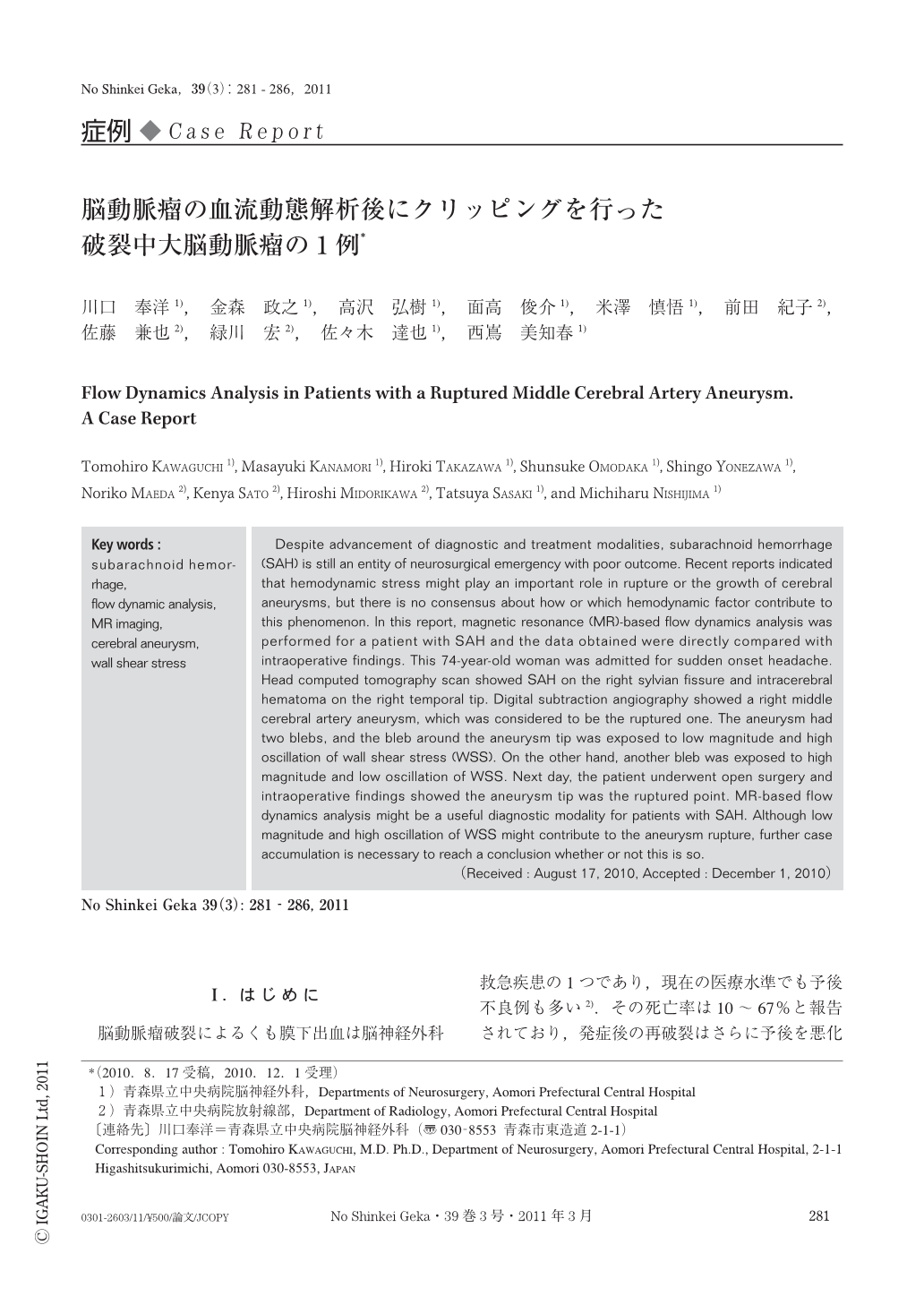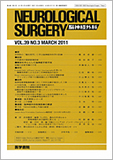Japanese
English
- 有料閲覧
- Abstract 文献概要
- 1ページ目 Look Inside
- 参考文献 Reference
Ⅰ.はじめに
脳動脈瘤破裂によるくも膜下出血は脳神経外科救急疾患の1つであり,現在の医療水準でも予後不良例も多い2).その死亡率は10~67%と報告されており,発症後の再破裂はさらに予後を悪化させる9,17).そのため,重症でない例(Hunt & Kosnik分類GradeⅠ~Ⅲ)では,年齢,全身合併症,治療難度などの制約がない限り,早期(発症72時間以内)に再破裂予防処置を行うことが勧められている3,9,10,15,16).
破裂脳動脈瘤に対する手術において,術前に破裂点を予測することは安全に手術を行う上で有用である4).これまで,脳動脈瘤における破裂点の検討は,blebの存在や親血管との角度など,形態学的および解剖学的情報をもとに予測されてきた.一方で,脳動脈瘤は常に血行力学的ストレスにさらされており,これらが血管壁に生理的作用を起こしていることは想像に難くない.そのため近年,血行力学的因子と動脈瘤破裂との関連性が注目されている.
血行力学的因子は剪断応力(wall shear stress:WSS)や壁圧,流線に代表され,なかでもWSSは血管壁面に沿って流れる粘稠な血液によって発生する摩擦力であり6),脳動脈瘤の形成や既存の脳動脈瘤の破裂・増大に関与すると考えられている4,6,14).しかしながら,動脈瘤破裂には高いWSSの関与と4),低いWSSの関与の報告があり14),未だ議論のさなかである.最近では剪断応力の心拍に伴う変動幅(振動剪断指数,oscillatory shear index:OSI)と動脈瘤破裂の関連も報告されている7,8).
これまでの血流動態解析の多くは,未破裂脳動脈瘤を中心に行われてきた.血流情報の収集は脳血管造影検査により行われ,また得られたデータを解析するために特殊な技術と経験を要し,解析自体に時間を必要とした.そのため,突然発症し緊急で外科治療を要するくも膜下出血患者の術前精査として施行し難かった.
今回われわれは,脳動脈瘤破裂によるくも膜下出血患者に対して,発症後術直前にMRIを用いた脳動脈瘤の血流動態解析を行い,術中所見と直接比較検討し得た1例を経験したので報告する.
Despite advancement of diagnostic and treatment modalities,subarachnoid hemorrhage (SAH) is still an entity of neurosurgical emergency with poor outcome. Recent reports indicated that hemodynamic stress might play an important role in rupture or the growth of cerebral aneurysms,but there is no consensus about how or which hemodynamic factor contribute to this phenomenon. In this report,magnetic resonance (MR)-based flow dynamics analysis was performed for a patient with SAH and the data obtained were directly compared with intraoperative findings. This 74-year-old woman was admitted for sudden onset headache. Head computed tomography scan showed SAH on the right sylvian fissure and intracerebral hematoma on the right temporal tip. Digital subtraction angiography showed a right middle cerebral artery aneurysm,which was considered to be the ruptured one. The aneurysm had two blebs,and the bleb around the aneurysm tip was exposed to low magnitude and high oscillation of wall shear stress (WSS). On the other hand,another bleb was exposed to high magnitude and low oscillation of WSS. Next day,the patient underwent open surgery and intraoperative findings showed the aneurysm tip was the ruptured point. MR-based flow dynamics analysis might be a useful diagnostic modality for patients with SAH. Although low magnitude and high oscillation of WSS might contribute to the aneurysm rupture,further case accumulation is necessary to reach a conclusion whether or not this is so.

Copyright © 2011, Igaku-Shoin Ltd. All rights reserved.


